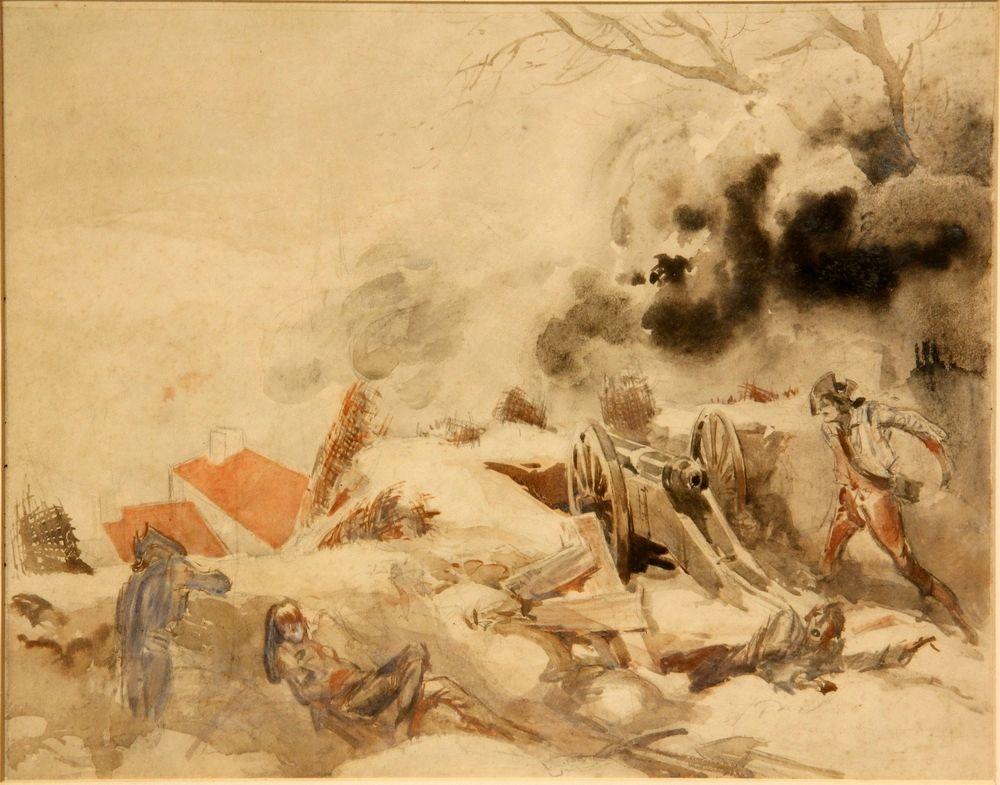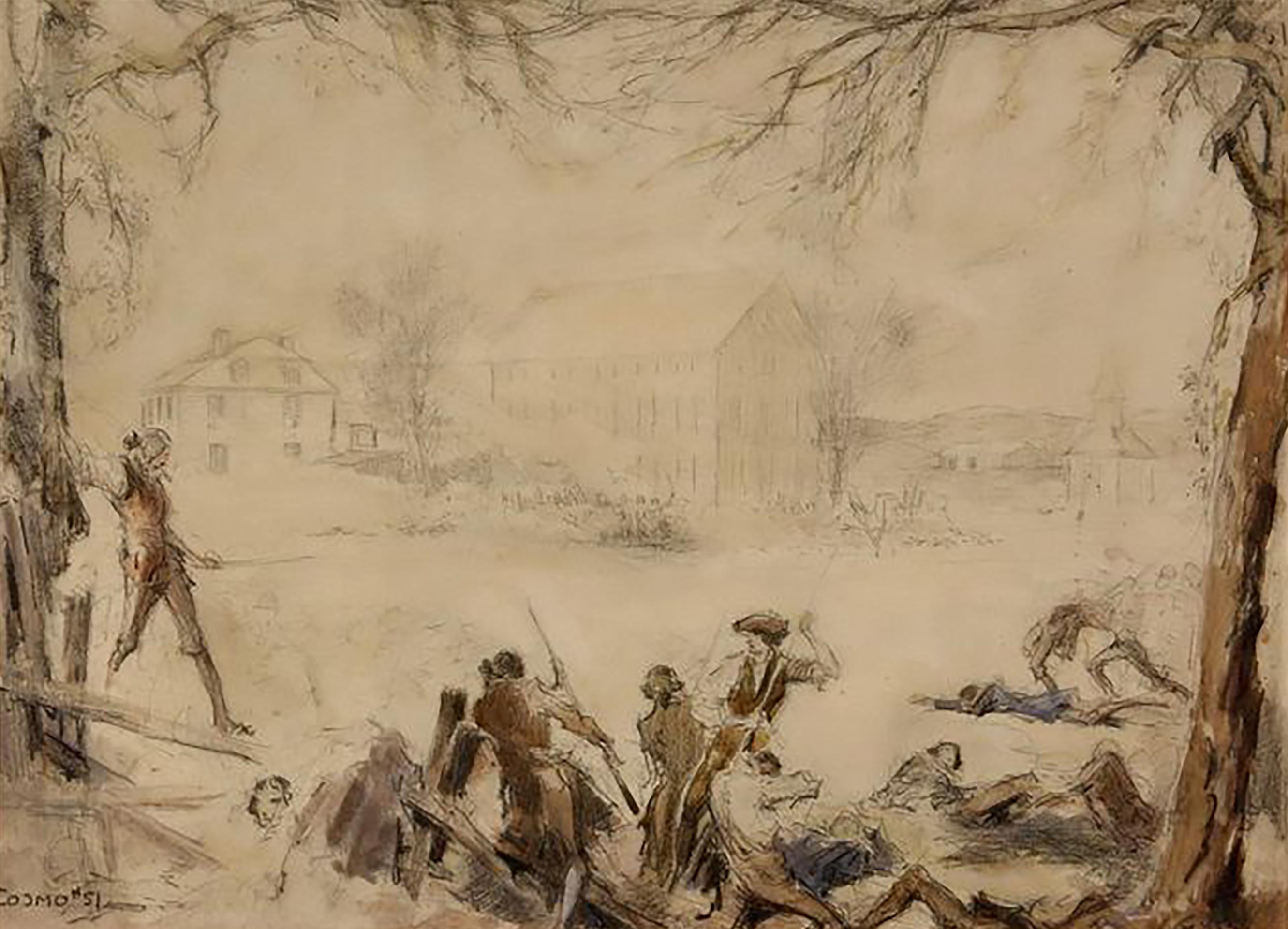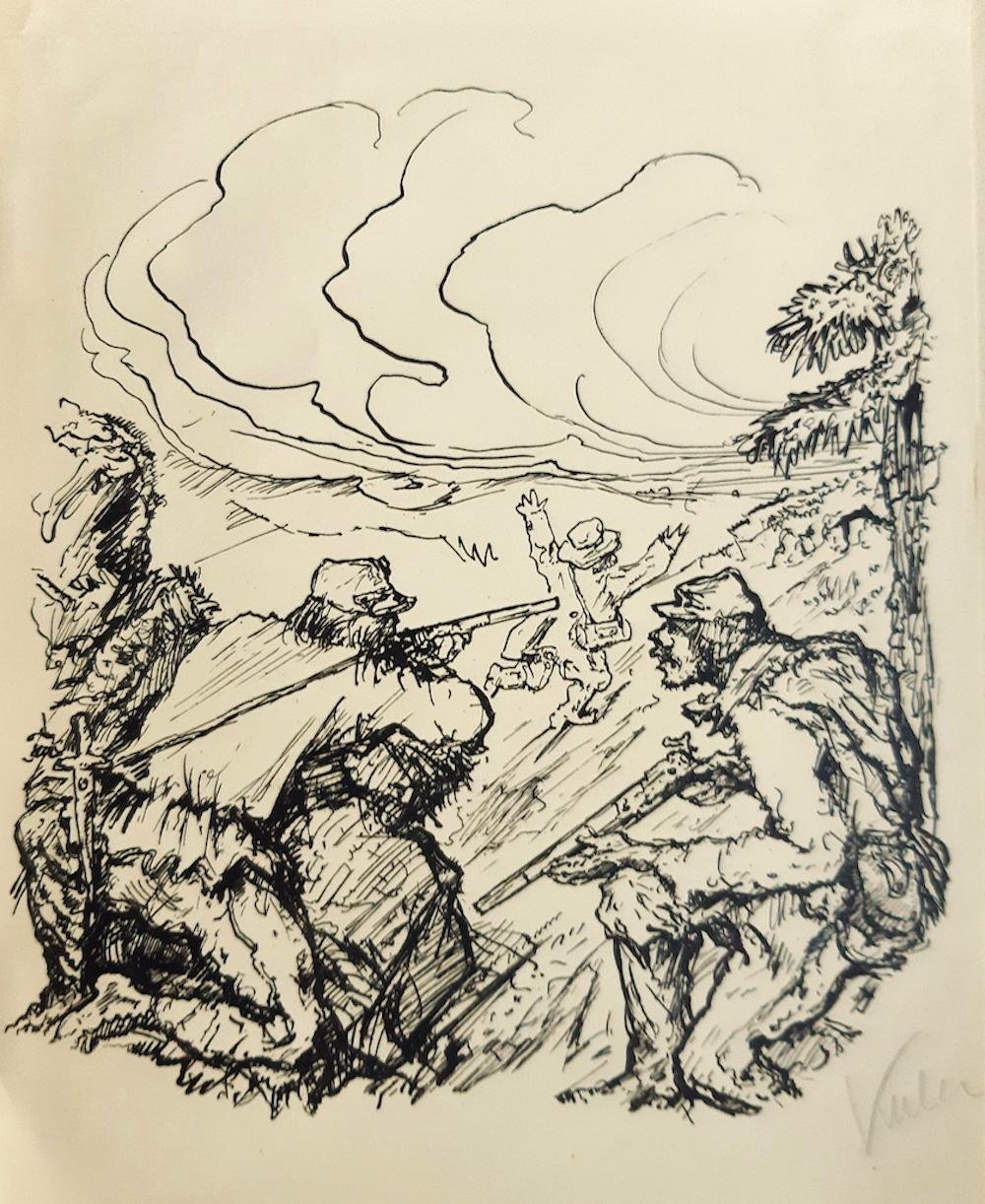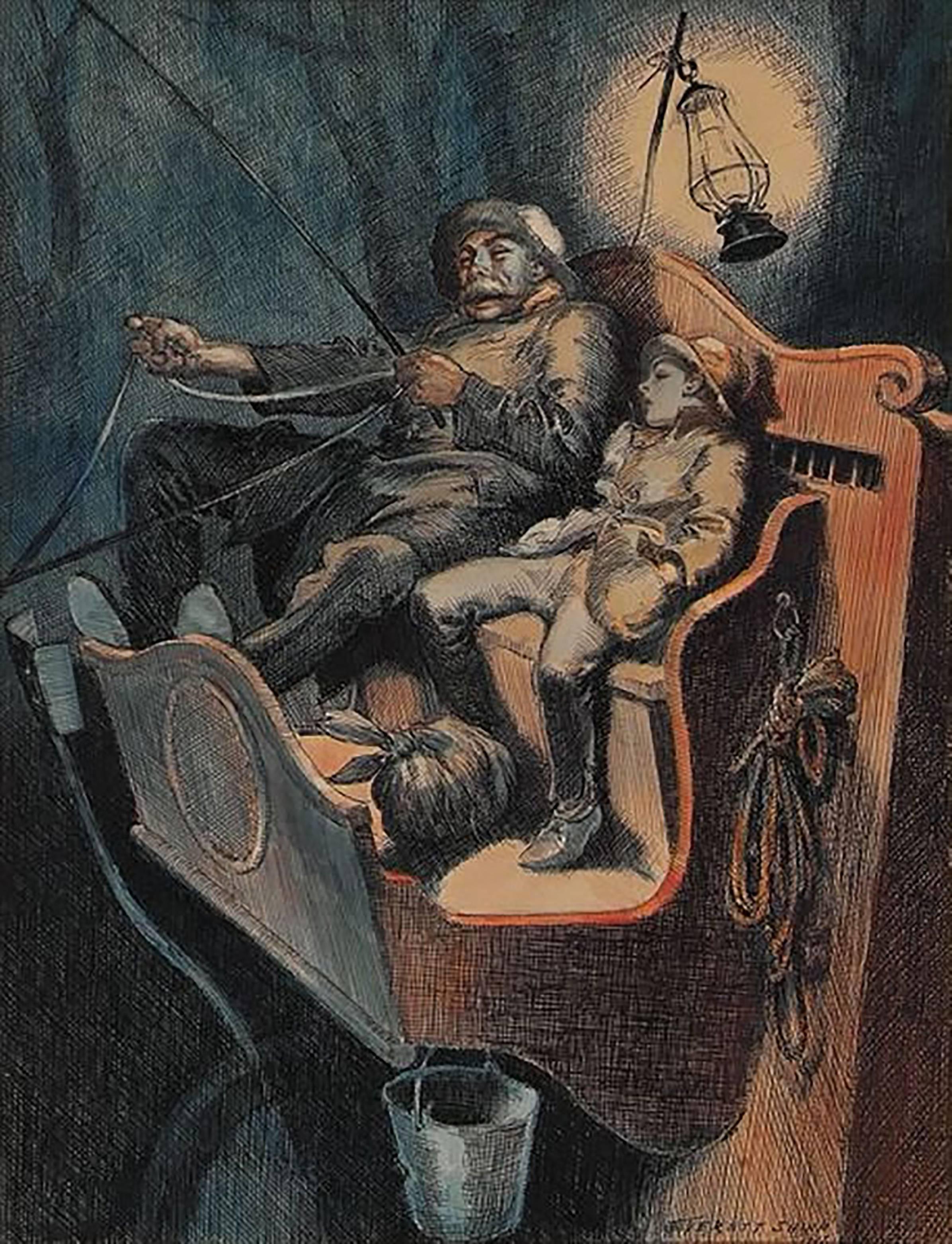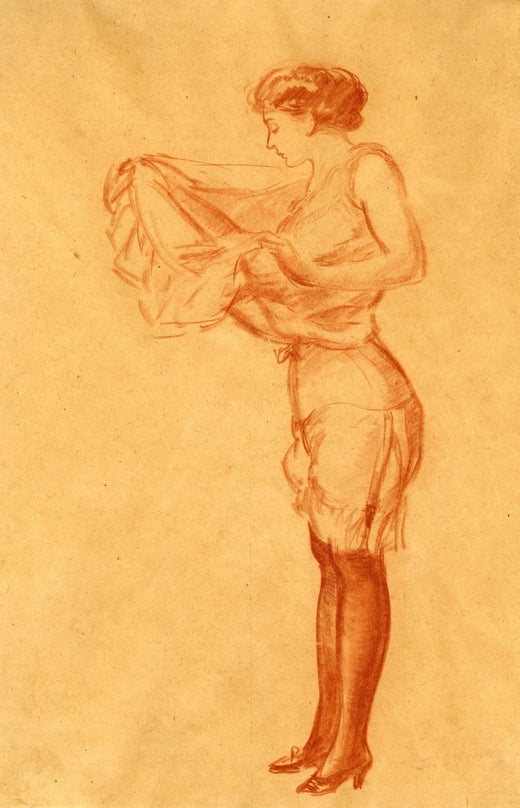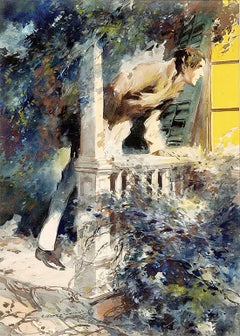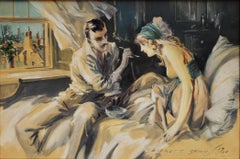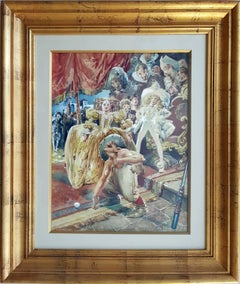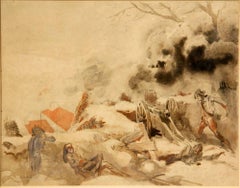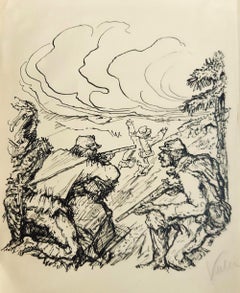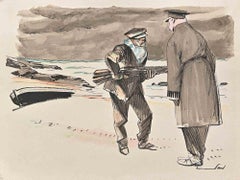Items Similar to Two Soldiers with Machine Gun
Want more images or videos?
Request additional images or videos from the seller
1 of 12
Everett ShinnTwo Soldiers with Machine Gun1941
1941
$8,500
£6,359.87
€7,381.14
CA$11,835.20
A$13,311.98
CHF 6,904.63
MX$161,484
NOK 87,546.65
SEK 82,386.30
DKK 55,065.37
Shipping
Retrieving quote...The 1stDibs Promise:
Authenticity Guarantee,
Money-Back Guarantee,
24-Hour Cancellation
About the Item
Arnold Finkel Gallery, Philadelphia, PA
Heritage
Some slight fading. Mounted to illustration board, Could be Unframed - Not sure if it is framed but the frame is old with wear.
Recommendation, reframe the art.
Signed lower right
- Creator:Everett Shinn (1876-1953, American)
- Creation Year:1941
- Dimensions:Height: 15 in (38.1 cm)Width: 13.25 in (33.66 cm)
- Medium:
- Movement & Style:
- Period:
- Condition:
- Gallery Location:Miami, FL
- Reference Number:1stDibs: LU38531114223
Everett Shinn
Everett Shinn, a future member of the Eight and remarkable, rather theatrical personality was born at Woodstown, New Jersey in 1873. Even more recent sources give 1876 as the year of Everett Shinn's birth (Zurier, Snyder, and Mecklenburg, 1995, p. 224) but the artist usually lied about his age to appear younger than he actually was. Edith DeShazo (1974, errata sheet) claimed that information from family members established the date of November 6, 1876 as Shinn's birthday. But if this is true, he would have enrolled at the Spring Garden Institute in Philadelphia to study industrial art at the age of twelve. Born to a Quaker named Isaiah Conklin Shinn and Josephine Ransley Shinn, Everett was their third child. He enjoyed a happy childhood as an undisciplined boy fond of sweets, acrobatics, and the circus (DeShazo, 1974, pp. 15-17). Shinn opted for the Pennsylvania Academy of the Fine Arts for instruction in the fall of 1893, and began as a staff artist for the Philadelphia Press. At that time William Glackens was working there as well, while John Sloan was at the Inquirer. A year later, Glackens was at the Press, and also, in 1894, George Luks joined the staff there. As DeShazo explained (1974, p. 29), "the Press art department became a meeting place for men both on the staff and off with similar artistic and literary interests." Members of the same group also met at Robert Henri's studio. By 1897, Shinn was in New York, working for the New York World where Luks had been for about a year. The rest of the "Philadelphia Four" (artist-reporters) would follow them before long. Shinn spent much of 1898 hounding the offices of Harper's until finally, the editor and publisher, Colonel George Harvey saw his portfolio, then commissioned a view of the Old Metropolitan Opera House in a snowstorm. The pastel appeared about a year later in the February 17th issue of Harper's Weekly, in 1900. Meanwhile, Shinn kept busy with decorative work (murals, screens, and door panels) at private residences and even in Trenton, New Jersey's City Hall. In 1899, the Boussod-Valadon Galleries gave Shinn his first one-man show. He continued to carry out commissions for illustrations (see Bullard, 1968). Shinn began exhibiting at the Pennsylvania Academy (1899-1908) and at the Art Institute of Chicago (1903-43).
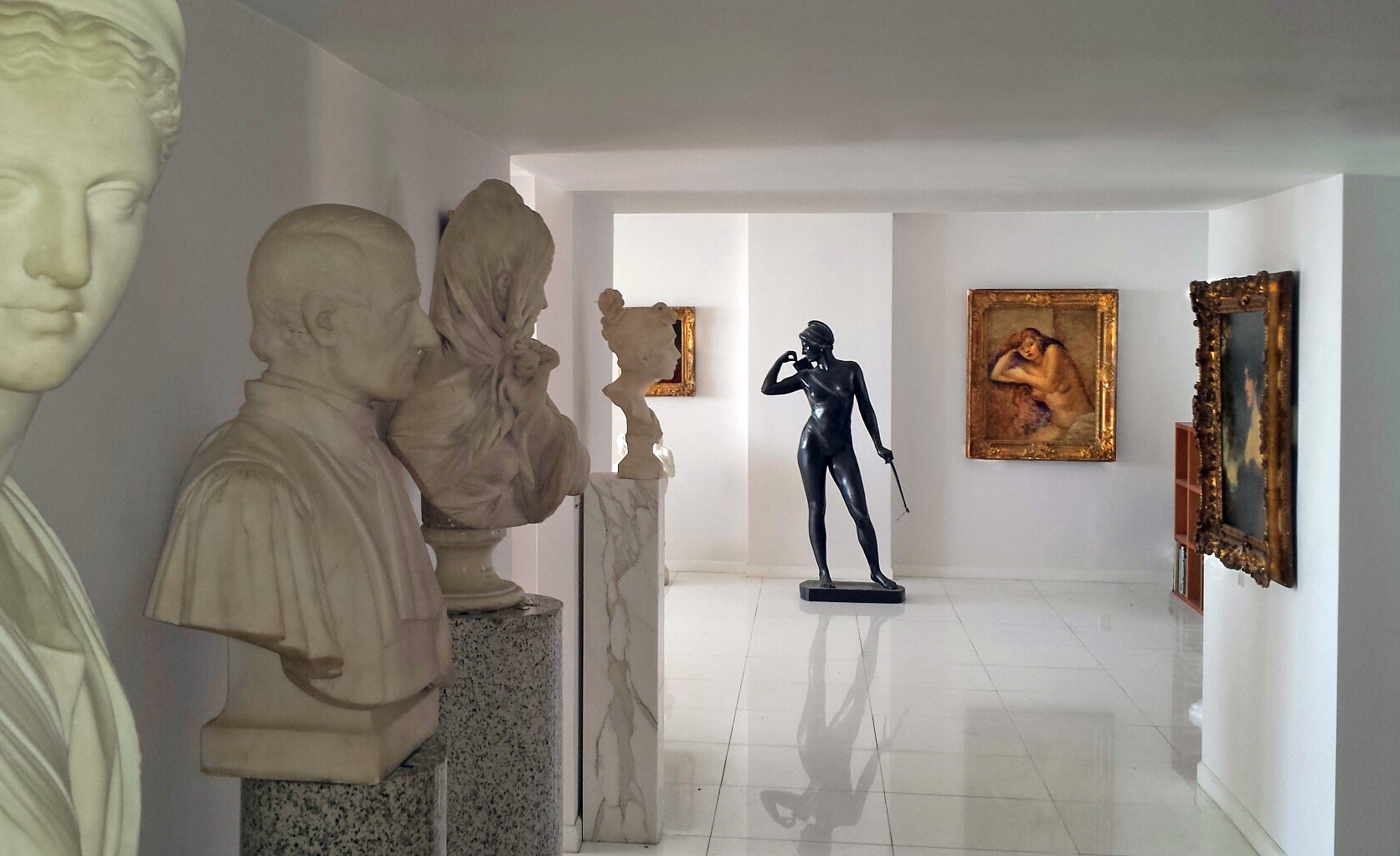
About the Seller
4.9
Gold Seller
Premium sellers maintaining a 4.3+ rating and 24-hour response times
Established in 2005
1stDibs seller since 2016
115 sales on 1stDibs
Typical response time: 1 hour
- ShippingRetrieving quote...Shipping from: Miami, FL
- Return Policy
Authenticity Guarantee
In the unlikely event there’s an issue with an item’s authenticity, contact us within 1 year for a full refund. DetailsMoney-Back Guarantee
If your item is not as described, is damaged in transit, or does not arrive, contact us within 7 days for a full refund. Details24-Hour Cancellation
You have a 24-hour grace period in which to reconsider your purchase, with no questions asked.Vetted Professional Sellers
Our world-class sellers must adhere to strict standards for service and quality, maintaining the integrity of our listings.Price-Match Guarantee
If you find that a seller listed the same item for a lower price elsewhere, we’ll match it.Trusted Global Delivery
Our best-in-class carrier network provides specialized shipping options worldwide, including custom delivery.More From This Seller
View AllFlight into Egypt
By Everett Shinn
Located in Miami, FL
Meticulously rendered in beautiful pastels colors account of biblical story.
Doyle New York
Category
1940s American Realist Figurative Drawings and Watercolors
Materials
Gouache, Pencil, Watercolor
$10,000 Sale Price
20% Off
Man looking into Window
By Everett Shinn
Located in Miami, FL
Original Magazine Illustration for a magazine like Harper's, Vanity Fair, Life, Look, and Judge
Shinn was an American realist painter and member of the Ashcan School. He also exhibited with the short-lived group known as "The Eight,"
Work is framed in an attractive gilt frame
Morris Weiss collection...
Category
1910s American Realist Figurative Drawings and Watercolors
Materials
Acrylic Polymer, Gouache, Pencil, Watercolor
$15,600 Sale Price
20% Off
Hearts Unreasoning, by Sarah Bernhardt The First of Six Romances of the French S
By Everett Shinn
Located in Miami, FL
Hearts Unreasoning, by Sarah Bernhardt The First of Six Romances of the French Stage -
McCall’s Magazine December 1920 interior illustration. The work is related to Shinn's fam...
Category
1920s American Impressionist Figurative Paintings
Materials
Oil, Board
$15,200 Sale Price
20% Off
Court Jester - Golden Age of Illustration
By Everett Shinn
Located in Miami, FL
Meticulously and carefully rendered period piece that reenact this magicaly moment. Works on Paper, Gouache, Watercolor over traces of pencil heightened with white on illustration ...
Category
1940s American Realist Figurative Drawings and Watercolors
Materials
Watercolor
Art Journalism - War Lessons, Illustration for Collier's, Female Illustrator
By Martha Sawyers
Located in Miami, FL
Marta Sawyers. Illustrator Journalist. She was sent to war-ravaged countries to “Paint the Story”.
What's unique here? This represents the work an Artist Journalist/War Correspondent...
Category
1940s Post-Impressionist Figurative Paintings
Materials
Pastel
Romantic Couple In Wartime Paris on Rainy Parisian Night
Located in Miami, FL
The technique and subject matter work well together in this loosely but masterfully rendered World War 1 romantic illustration of a Soldier and a Parisian woman. Even though this wo...
Category
1930s Romantic Figurative Drawings and Watercolors
Materials
Ink, Watercolor, Pencil
You May Also Like
Attributed to; Design for the Battle of Brooklyn Heights Scene in 1924 Film
By Everett Shinn
Located in Fort Washington, PA
Medium: Watercolor and Graphite on Illustration Board
Signature: Unsigned, Christies Stamp Verso.
In silver molded frame, french-lined mat, glazed. OS: 18 1/2" x 22", SS: 11" x 15". Shinn took over from Joseph Urban as the Art Director on the William Randolph Hearst's Cosmopolitan Pictures film, shot in New York City and Tarrytown, NY. Directed by E. Mason Hopper, starring Marion Davies...
Category
20th Century Landscape Drawings and Watercolors
Materials
Watercolor, Illustration Board, Graphite
Attributed to; Design for the Battle of Lexington Scene in 1924 Film "Jani
By Everett Shinn
Located in Fort Washington, PA
Medium: Watercolor and Graphite on Illustration Board
Signature: Unsigned, Marked "Cosmo #51" Lower Left
Contact for exact dimensions.
Christies stamp verso. In silver molded frame, french-lined mat, glazed. OS: 18 1/2" x 22", SS: 11" x 15". Shinn took over from Joseph Urban as the Art Director on the William Randolph Hearst...
Category
20th Century Landscape Drawings and Watercolors
Materials
Watercolor, Illustration Board, Graphite
Two Soldiers - Original Lithograph by A. Kubin - 1933
By Alfred Kubin
Located in Roma, IT
Zwei Soldaten is an original lithograph on paper, realized by Alfred Kubin in 1933, Hand-signed in pencil.
Sheet dimension: 27,5 x 22,5cm.
In very good conditions.
References:
Arn...
Category
1930s Symbolist Figurative Prints
Materials
Lithograph
$521 Sale Price
25% Off
Two Men - Watercolor Drawing by Hermann Paul -1890s
Located in Roma, IT
Two Men is a Watercolour Drawing realized by Hermann Paul.
Hand signed on the lower right corner.
Good condition.
René Georges Hermann-Paul (27 December 1864 – 23 June 1940) was ...
Category
1890s Modern Figurative Drawings and Watercolors
Materials
Paper, Watercolor
$431 Sale Price
25% Off
Rifleman, 20th Century English Artist, Watercolour and Ink, War Theme
By V. Ward
Located in London, GB
V Ward
Rifleman
Watercolour and ink
Signed and dated 1918, lower right
Image size: 11 x 8 inches
Category
20th Century Figurative Drawings and Watercolors
Materials
Ink, Watercolor
Illustration for the book Toby Tyler or Ten Weeks with a Circus
By Everett Shinn
Located in Fort Washington, PA
This illustration was used in Toby Tyler or Ten Weeks with a Circus by James Otis. Published in 1937 by The John C. Winston Company - "The Children's Bookshelf" series. The book features wonderful color plates and black & white illustrations by Everett Shinn.
The full caption reads: "Toby tried very hard to go to sleep."
Toby Tyler tells the story of a ten-year-old orphan who runs away from a foster home to join the traveling circus only to discover his new employer is a cruel taskmaster. Toby's friend, Mr. Stubbs the chimpanzee, reinforces the consequences of what happens when one follows one's natural instincts rather than one's intellect and conscience, a central theme of the novel.
Date: 1937
Medium: Watercolor on Paper
Dimensions: 18.00" x 12.50"
Signature: Signed Lower Right
Toby Tyler Book Illustration
Exhibitions: Norman Rockwell Museum...
Category
1930s Figurative Drawings and Watercolors
Materials
Paper, Watercolor
